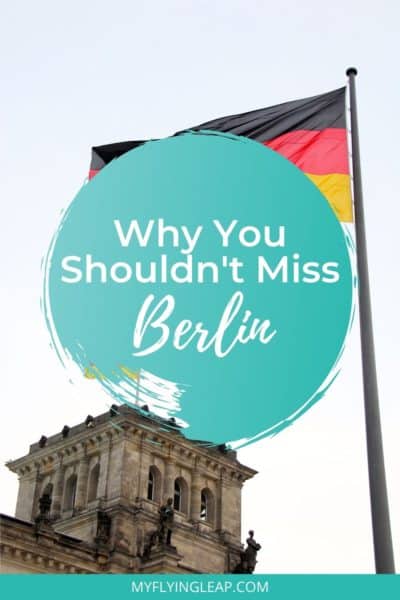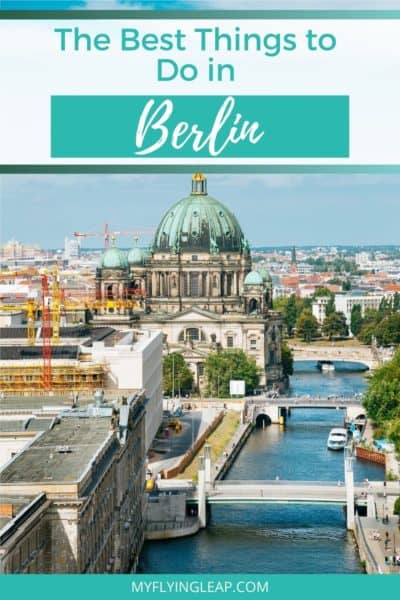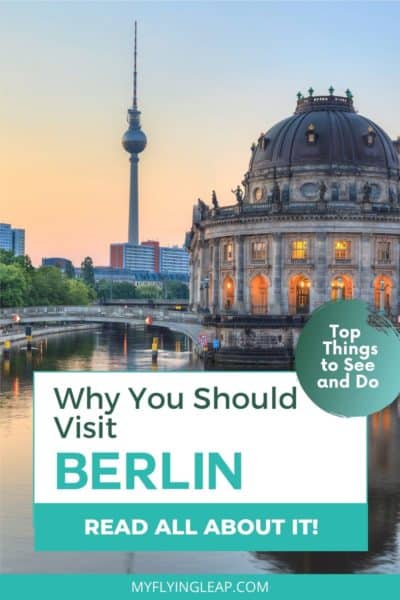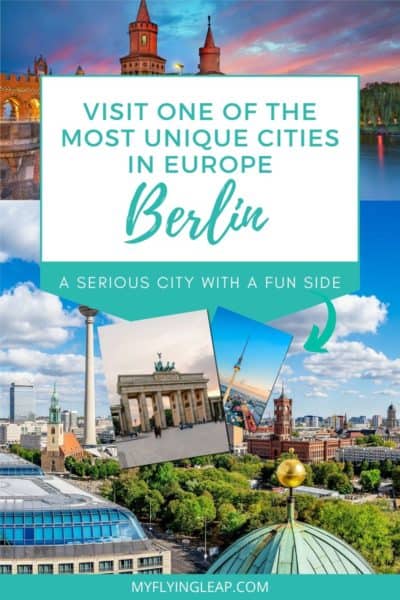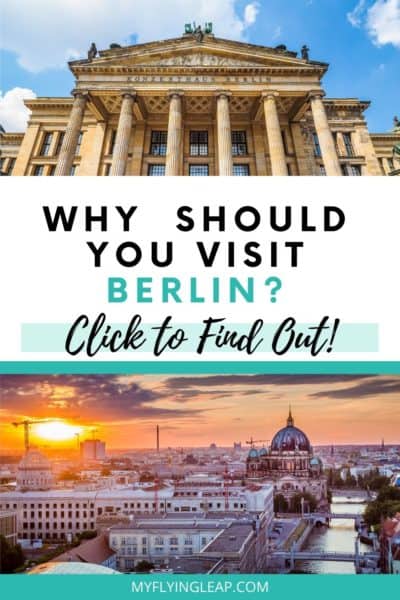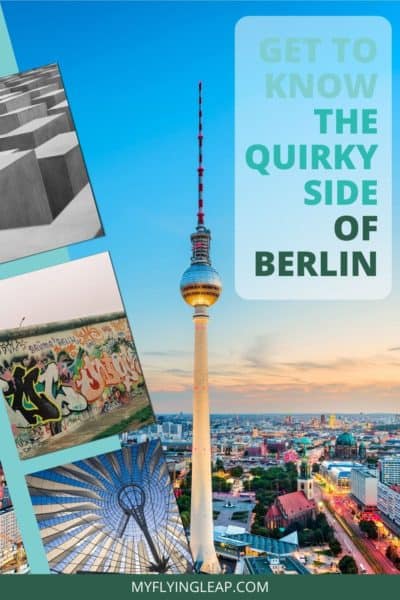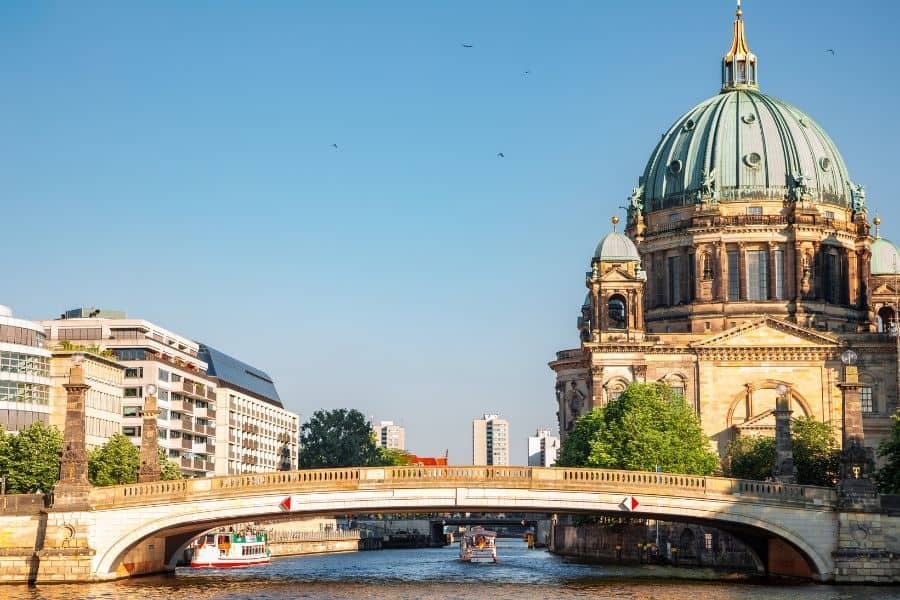19 Fun and Quirky Things to Do in Berlin
A visit to Berlin is unlike almost any city in Europe. Berlin balances a fun and quirky side with a somber and respectful side, remembering its not-so-distant past. This isn’t a rigid and refined city, but one that seems to accept openly and almost joyfully highlight its differences.
You’ll find an unapologetic city that acknowledges its dark past but looks to the future with a youthful and vibrant energy. There are many things to do in Berlin, and here are some of my favorites and the most popular.
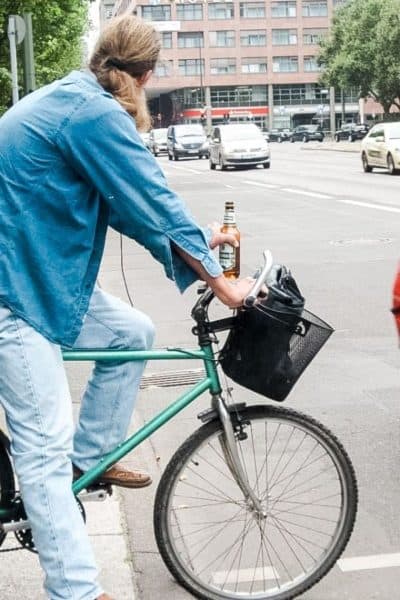
Some links in this article may be affiliate links, which means that if you purchase through them, I receive a small commission. This will never cost you extra. Please read the disclosures to learn more.
1. Checkpoint Charlie
Most people have heard of Checkpoint Charlie as it has garnered attention in spy novels and even in a James Bond movie. It’s the site of a former border crossing in the Berlin Wall during the Cold War between Eastern and Western Germany.
Since the Berlin Wall came down, Checkpoint Charlie stands as a symbol of the division of Germany during the Cold War.
This checkpoint was one of several established by the Allies. It got its name from the alphabet, as did the other gates, Alpha, Bravo, and Charlie. The other checkpoints were used, but Checkpoint Charlie became the most famous one used by foreigners.
It garnered a lot of attention, first with a tank confrontation between American and Soviet troops. It was also the site of numerous escape attempts from people in East Germany trying to get to the West side.
Checkpoint Charlie is now a popular photo op for tourists. People take pictures of the sign, the barrier and checkpoint booth, and the flag and stack of sandbags.
If you want to learn more, the Mauer Museum (Wall Museum) is nearby, waiting for you to stop in. You can learn about the Cold War, important historical events, and what it was like living in Germany then. You can also see a segment of the wall to imagine what it must have been like to live within it.
Checkpoint Charlie is on the corner of Friedrichstraße and Zimmerstraße at Friedrichstraße 43-45, 10117 Berlin, Germany. The Mauermuseum is right next to Checkpoint Charlie, also located at Friedrichstraße 43-45, 10969 Berlin, Germany. It costs 14.50 Euros ($15.30 USD) and it’s open from 10 a.m. to 8 p.m. daily.
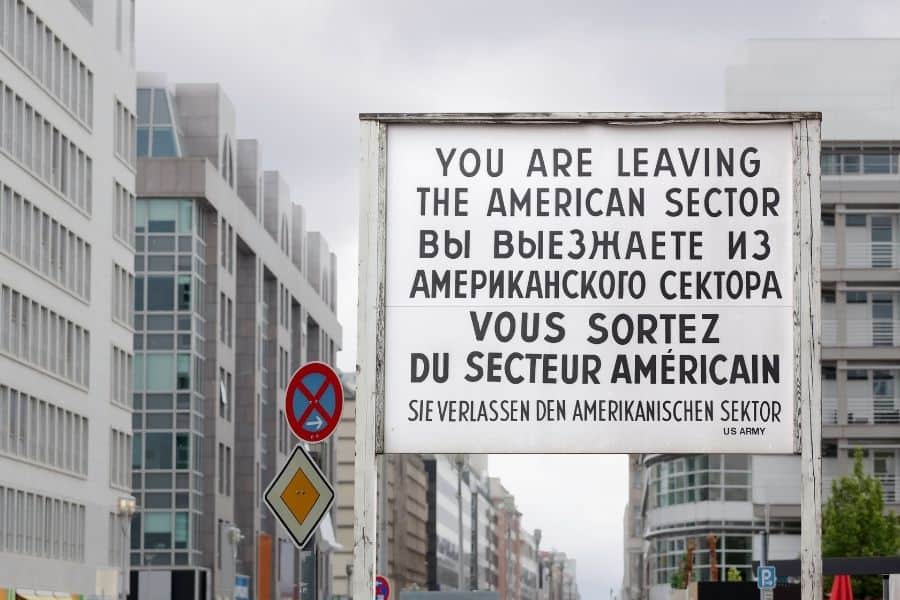
2. Eastside Gallery
Berlin has several special places paying homage to its past and expressing optimism for its future. One of these is the Eastside Gallery. It’s the largest open-air gallery in the world, with over 4,000 feet (1317 meters) of the Berlin Wall painted by artists from around the world expressing the joy of the fall of the wall and the end of the Cold War.
In 1990, from February to September, more than 118 artists representing 21 countries worked on this project. It’s a very touching place to visit that found a way to make something that was so painful to many into something beautiful. It’s one of the most famous landmarks in Germany and one not to be missed when you visit!
Unfortunately, a lot of graffiti is littering the artwork, and there has been some damage since it was exposed to the elements. Even still, it’s worthwhile to visit and enjoy the artists’ perspectives and a great representation of quirky Berlin.
The gallery is at the former borders of the Soviet and American sectors on the Spree. It’s near the Oberbaum Bridge (Oberbaumbrücke), which is picture-worthy. Cross the bridge to the Kreuzberg neighborhood if you’re looking for affordably-priced eats.
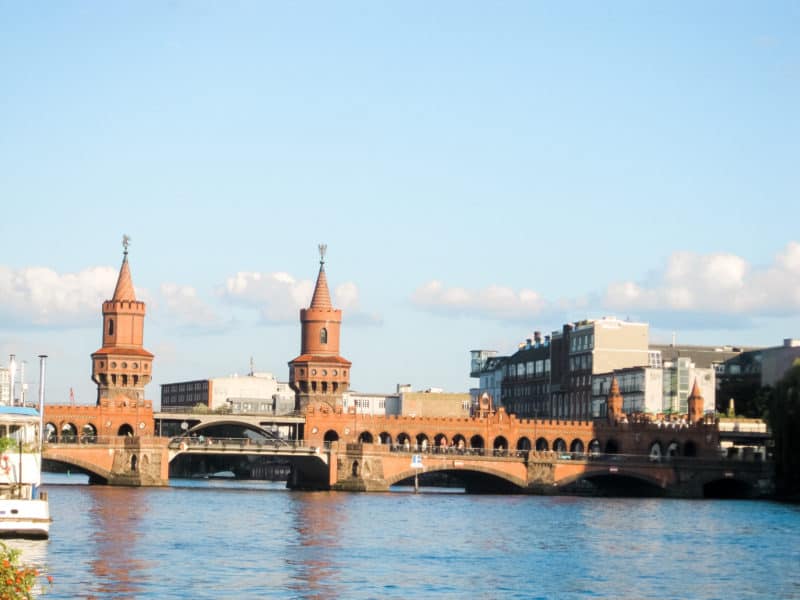
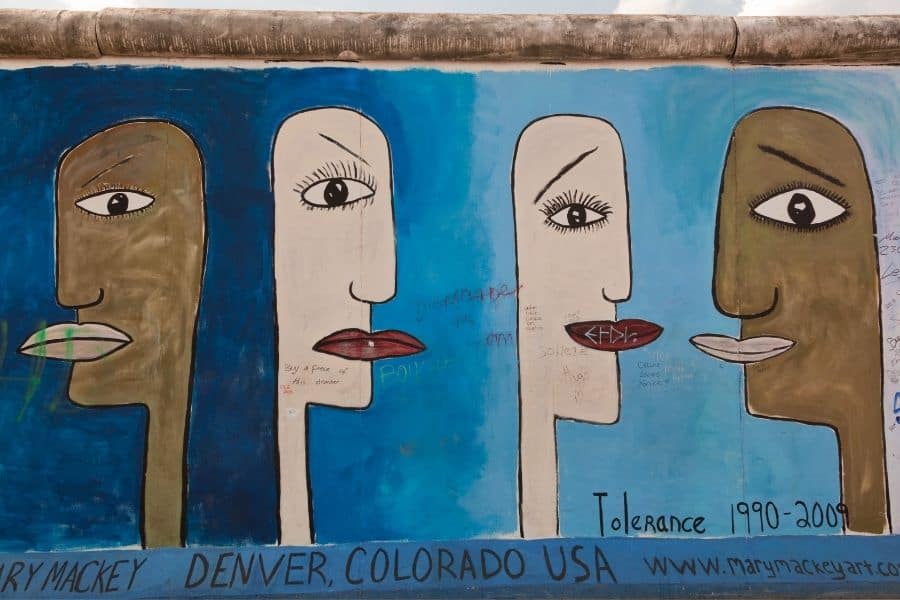
The Eastside Gallery is located at Mühlenstraße 3-100, 10243 Berlin, Germany. There’s no cost to visit.
3. Brandenburg Gate (Brandenburg Tor)
The most iconic landmark in Berlin is the famous and striking Brandenburg Gate. Though it was once a symbol of the German division during the Cold War, it has now become a beloved national symbol of unity and peace for the German people.
It was built between 1788 and 1791 for Friedrich Wilhelm II of Prussia, inspired by Propylaea, the gateway to the Athens Acropolis. He wanted a suitably impressive architectural statement for the area. It’s made from sandstone, and while there were once 18 gates in the city, it’s the only one that remains.
It has twelve Doric columns, six on each side. On top is a sculpture created by Johann Gottfried Schadow of a quadriga, or a chariot drawn by four horses led by Victoria, the Roman goddess of victory.
The gate was the site of some important times in history, and it was a Nazi symbol of power during World War II. It suffered damage at the war’s end, but it remained standing. One of history’s most recent and famous moments at the gate was U.S. President Ronald Regan’s speech, “Mr. Gorbachov, tear down this wall!”
It’s a beautiful place to visit and worth seeing both during the day and at night, as it’s lit up and equally impressive.
Brandenburg Gate is located in Pariser Platz, 10117 Berlin, Germany.
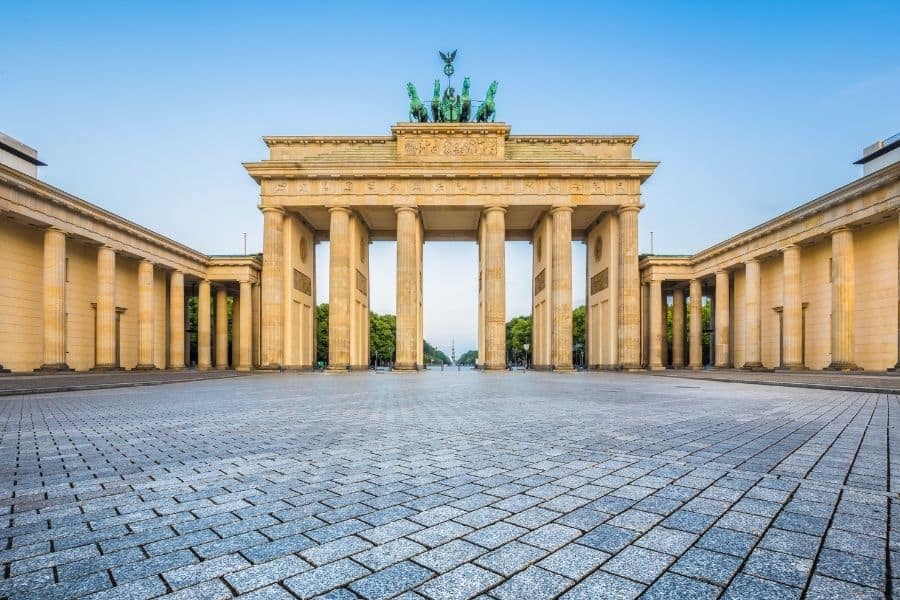
4. Reichstag
The Reichstag is only around a block from Brandenburg Gate, housing the German Parliament (Bundestag). This impressive neo-Baroque building survived wars, fire, bombing, and Germany’s division to rise again as a symbol of democratic modern-day Germany.
The Reichstag was initially opened in 1894. It was used until 1933, when it was badly damaged by a fire. Though stabilized in the 1960s, it wasn’t fully restored until the 1990s and reopened as the Bundestag in 1999.
It’s a popular place to visit for anyone interested in current affairs or political history. A popular thing to do during any visit to Berlin is go to the top of the Reichstag. However, you must book in advance and fill out an online form with your preferred time slots at least three business days before you plan to go.
It’s one of the rare parliament buildings open to the public. When you book, you can explore the building and go to the top of the large glass dome to enjoy the 360-degree views of Berlin.
The Reichstag Building is located at Platz der Republik 1, 11011 Berlin, Germany. Admission is free, though you must register three business days in advance. It’s open from 8 a.m. to midnight. There is a rooftop restaurant, and you can book a reservation when you reserve your visit.
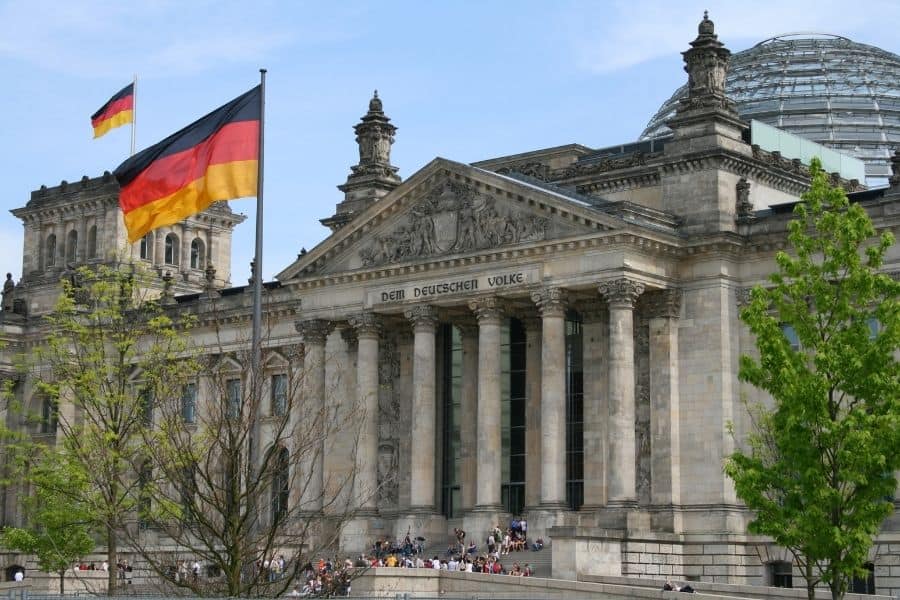
5. Museum Island
The five world-class museums on Berlin’s Museum Island (Museuminsel) are so impressive that they even received recognition as a UNESCO World Heritage Site. Even if you’re not a “museum person,” you’re likely to find something of interest here at one of these incredible museums.
Spree Island also called Museum Island due to these museums, houses some incredible treasures. The museums are Neues Museum, The Altes Museum, Alte Nationalgalerie, Pergamonmuseum, and Bode Museum. There are many other museums in Berlin; some are even mentioned in this piece, and these five are considered the pinnacle of Berlin’s museum collection.
6. Pergamonmuseum
I absolutely LOVED this museum, and it is easily one of my top five museums of all time. Why? Because you feel like you’re actually walking through history in many of the exhibits!
There are three museums that comprise the Pergamon: The Museum of the Ancient Near East, the Museum of Islamic Art, and The Collection of Classical Antiquities. It’s a history museum like you have never seen.
For starters, walk through the reconstructed Ishtar Gate of Babylon. There is something so incredible walking through this impressive gate built to scale, thinking about this amazing time in history.
Be prepared to be wowed by the incredible Pergamon Altar, built in Greece in the 2nd century BC. It was discovered in the late 19th century and reconstructed in the museum. It’s massive and really impressive, and you can actually see a 3D rendering of the Pergamon Altar online. It’s part of one of the most important collections of Greek and Roman art in the world, housed in the Pergamon, Altes Museum, and Neues Museum.
This museum also houses one of the most impressive Islamic art collections outside the Islamic world. It includes artifacts from Muslim, Christian, and Jewish groups from the 7th century to the 19th century.
Some of the most impressive exhibits are the caliph’s palace of Mshatta with its intricate stone facade and the beautifully detailed 17th-century room from a merchant’s home in the Syrian city of Aleppo.
Pergamon Museum is located at Bodestraße 1-3, 10178 Berlin, Germany. This museum is really popular and gets busy so it’s a good idea to buy tickets online for 12 EUR ($14.30 USD). Plan for at least 2 hours for a visit, and more if you’re a history nerd. It’s open daily from 10 to 6.

7. Alte Nationalgalerie
Another museum at Museum Island is the Alte Nationalgalerie. It is the original national gallery that was established in 1861. If you’re an art lover, this is your place! It hosts an incredible art collection and has the largest collection of 19th-century artwork in Germany.
You’ll also see works of art from early Modernism to the French impressionists like Monet, Manet, and Cézanne. It’s a really popular museum to see, so getting a ticket online in advance is worth it so you can skip right ahead of the long line to head right in.
Alte Nationalgalerie is located at Bodestraße 1-3, 10178 Berlin, Germany. It’s open from 10 to 6 Tuesday through Sunday, and it’s closed on Mondays. Tickets cost 12 Euros (close to $12.75 USD).
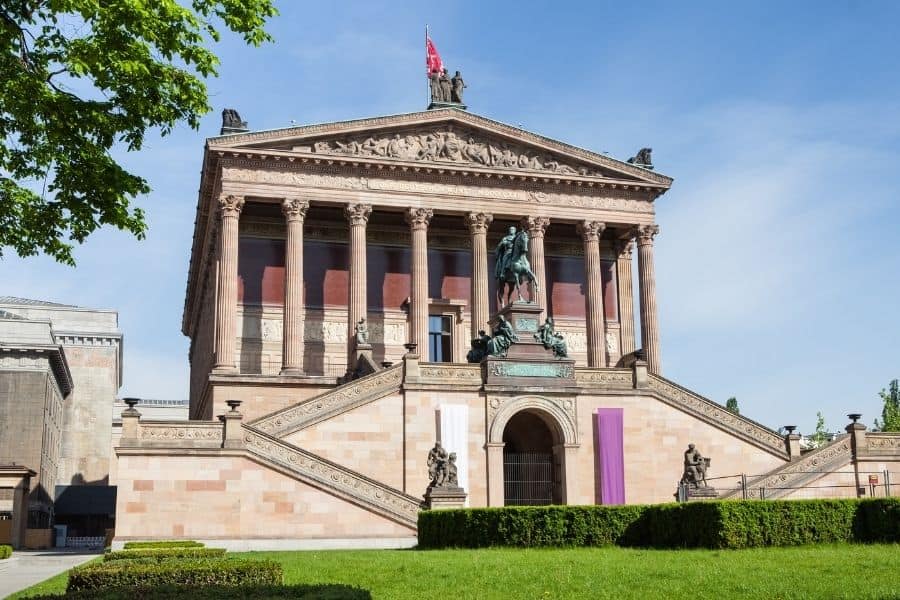
8. Berlin Cathedral
The Berlin Cathedral, located on Museum Island, is one of the most impressive structures in the city. Emperor William II built it between 1894 and 1905 in the Renaissance and Baroque Revival styles. It’s the largest Protestant church in the country.
Like many buildings in Berlin, it was badly damaged during World War II. The original interior was restored in 2002. Climb 270 steps to the top to get an incredible panoramic view from the dome. It’s truly one of the most stunning views in the city.
The Berlin Cathedral is located at Am Lustgarten, 10178 Berlin, Germany. It’s open from 10 to 5 in the winter and 9 to 8 in the summer daily. On Sundays, it’s only open after noon, as church services are offered in the morning. It costs 9 Euros ($9.50 USD) to enter, and you can rent an audioguide for a few Euros more.
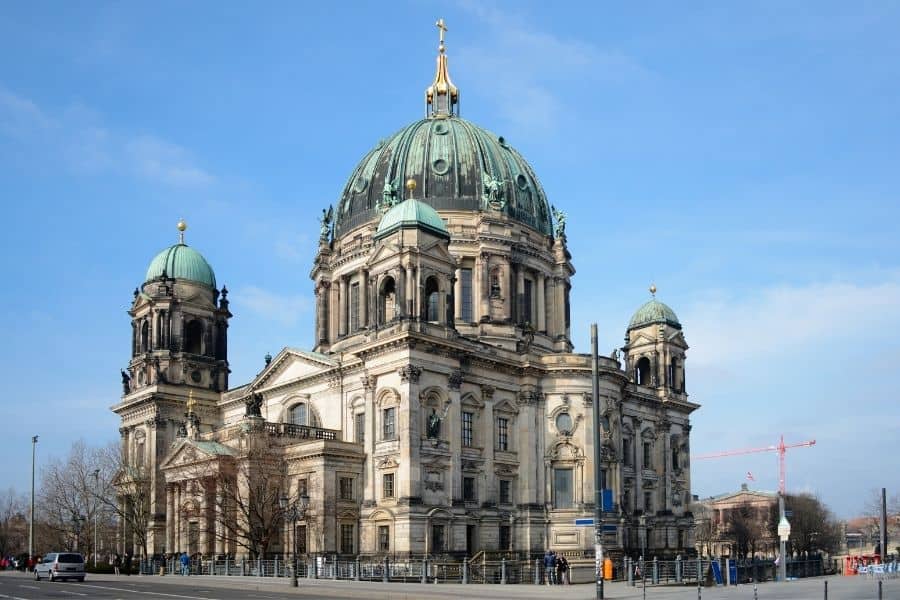
9. Gendarmenmarkt
Much of Berlin was rebuilt in the 1960s and 1970s. The architecture in many areas of the city is very reminiscent of that time. I went to Berlin expecting the magnificent European architecture I saw through most of the continent and was very disappointed when I got to Berlin.
While I didn’t find the architecture worthy of note overall, some areas were truly impressive. One of them was Gendarmenmarkt.
I didn’t see this on any list of recommendations to see in Berlin, and honestly, I stumbled upon it as it wasn’t far from the apartment I rented. It’s a great place to sit and watch the locals bustle by, and I spent most late afternoons nursing a drink here, watching the world go by.
Gendarmenmarkt is a square with the Berlin Concert Hall and a German and French Church. In the middle of the square is a large statue of poet Friedrich Schiller.
The square was created at the end of the 17th century and modified in 1773. It has been restored to its former glory since World War II.
It’s a great place to wander, and there are several outdoor restaurants where you can get a drink and people-watch.
The location is Gendarmenmarkt, 10117 Berlin, Germany.

10. Jewish Museum Berlin
The Newish Museum Berlin is the largest Jewish museum in all of Europe. It opened in 2001 and presents the history of the Jews in Germany from the Middle Ages to today.
The three buildings were designed by architect Daniel Libeskind, who was originally selected to design the reconstruction of the World Trade Center in New York City before political infighting derailed the effort.
It’s an impressive museum with many different kinds of interactive exhibits. You can see artifacts remaining from people from hundreds of years ago and read more about them and their lives. Watch video clips from the past and wander through the halls of history.
Some of the stories you’ll learn are fascinating, and others may make you cry. There are many beautiful and poignant exhibits, and you’ll leave with a much better understanding of the German Jews. This museum has many truly powerful and beautiful exhibits, and it’s worth visiting.
The Jewish Museum Berlin is located at Lindenstraße 9-14, 10969 Berlin, Germany. It’s open daily from 10 to 7, and it’s free to visit for the core exhibits. Some temporary exhibits are available for 8 Euros ($8.50).
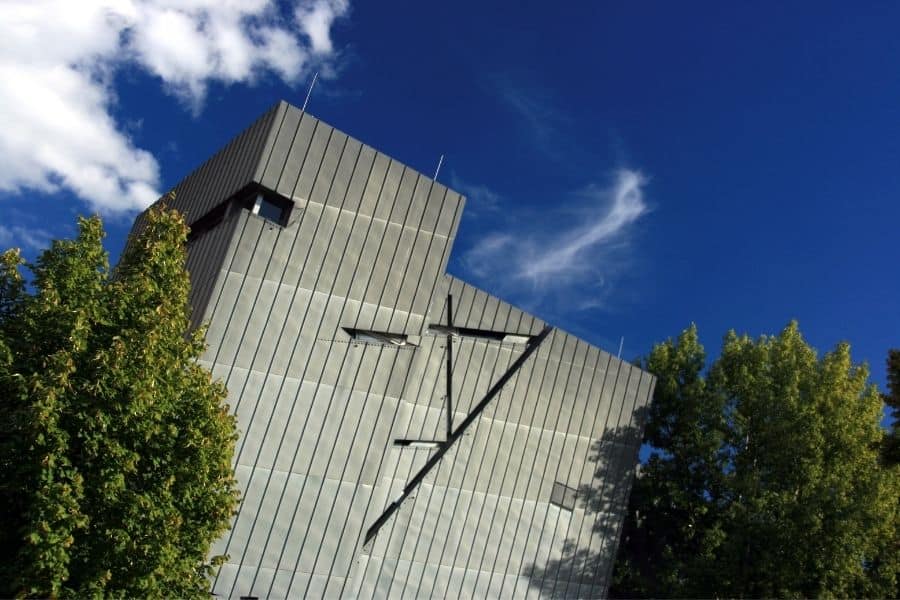
11. Charlottenburg Palace (Schloss Charlottenburg)
If you have read my other articles on travel in Europe, you probably know I’m pretty much obsessed with castles, palaces, and historic architecture. So, when I read about Charlottenburg Palace, you can bet it was high on my list of things to see in Berlin.
It did not disappoint! Not only can you tour the palace and the grounds, but you can also enjoy special events like concert experiences and the Berlin Residence Orchestra.
Charlottenburg Palace was built in 1699 as the summer palace for Sophie Charlotte, the wife of King Friedrich I. Sadly, though, she didn’t live to see the final construction of it. It’s a huge structure and Berlin’s largest palace built in the Baroque style.
The palace is large and opulent, with many impressive rooms. They feature frescoes, ornate plasterwork, and gilding. The palace was badly damaged during World War II, so much of it was extensively and painstakingly rebuilt to the original designs. It houses priceless art collections, including crown jewels and royal porcelain and silver.
The grounds may actually be even more impressive than the inside of the palace, designed in the English and French styles. It’s a large property with ponds, fountains, hedges, and more.
Charlottenburg Palace is located at Spandauer Damm 10-22, 14059 Berlin, Germany. It’s open from Tuesday to Sunday. From April to October, it’s open from 10 to 6, and from November to March, it’s open from 10 to 4:30. It costs 17 Euros (around $18 USD) to visit the old palace and the new wing.
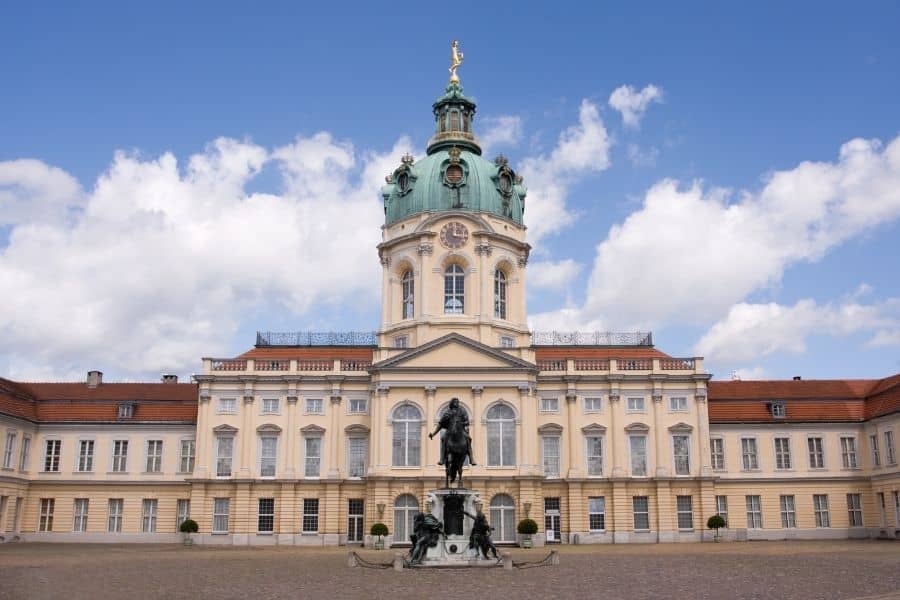
12. Tiergarten (Großer Tiergarten)
The Tiergarten is a massive inner-city park in the Tiergarten district of Berlin. It’s the most popular inner-city park and one of the largest in Germany.
It was established in 1527 as a hunting area for Friedrick III. The park slowly expanded, and later, hunting became less popular in this area as the city population expanded.
If you have been to Central Park in New York City or Lumpini Park in Bangkok, the Tiergarten is a similar rendition. It’s sometimes known as the “green lung” of Berlin. It’s an impressive garden park in the center of this large city.
Tiergarten is a great place to get out of the city for a bit, and you’ll be joined by joggers, walkers, cyclists, and people enjoying a picnic or napping in the sun.
Brandenburg Gate is on one end of the park, bordering the popular shopping district, Potsdamer Platz. Wander through the many tree-lined paths in the park to see the impressive statue collection. It’s a great place to unwind a bit with the feeling you’ve left the city.
Here is a map of the Tiergarten.

13. Berlin Holocaust Memorial
Very close to Brandenburg Gate and the Tiergarten is the Berlin Holocaust Memorial, also called the Memorial to the Murdered Jews of Europe. It was built between 2003 and 2004 and opened in 2005 on the 60th anniversary of the end of World War II in Europe.
New York architect Peter Eisenman designed this memorial. It’s a place of contemplation, remembrance, and warning. Two thousand seven hundred eleven concrete slabs are arranged in a grid pattern of varying heights and widths in rows. The area is on a slight slope, and though the slabs are in rows, they are partially askew, giving visitors a sense of uncertainty.
Wander the paths to consider both the past and the future. Visit the Place of Information, an underground information center with information on the victims of the Holocaust. You can view pictures, farewell letters, diaries, and short biographies. It’s a heavy place to visit, but it’s worth paying respects to.
Map of the Berlin Holocaust Memorial. There is no cost to visit.
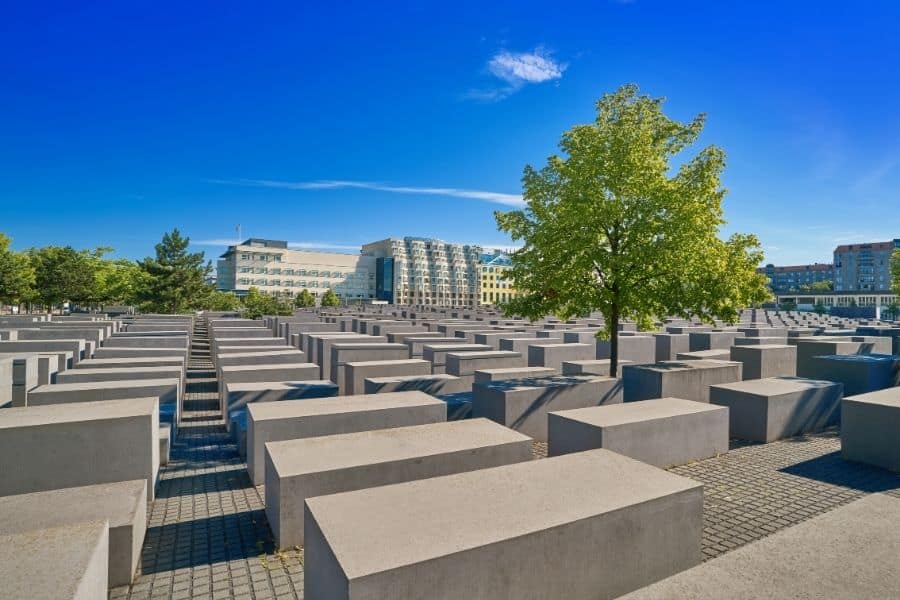
14. Christmas Markets in Berlin (Weinachstmarkt Berlin)
Christmas markets are big in Germany, and that’s no different in Berlin. There are over 50 annually in Berlin, and that count sometimes goes as high as 100. So, if you’re visiting from the end of November (some start as early as the week of Thanksgiving) into early January, it’s worth checking them out. Even if only for the glühwein!
These outdoor markets are a lot of fun and a great place to enjoy the local food and drink. Beer is, of course, always available, and another fun thing to try for wine lovers is glühwein.
Oh, did I mention that already? It’s mulled spiced wine, and it’s really good, especially on a cold day. But be careful not to breathe in as you drink it—just trust me on that!
Some popular foods to check out are brezel (big soft pretzels), bockwurst (sausage), and marillenknödel (apricot dumplings). Yum! And you’ll probably smell lots of chestnuts roasting (maroni).
You can find some of the top Christmas markets all over Berlin. Some worthy of note:
- Gendarmenmarkt (a square that I loved visiting!)
- Charlottenburg Palace
- Rotes Rathaus
- Alexanderplatz
- Kaiser Wilhelm Memorial Church
- Lucia Christmas Market at Kulturbrauerei (Scandanavian)
15. Berlin TV Tower (Berliner Fehrsehturm)
The Berlin TV Tower was built between 1965 and 1969 by the German Democratic Republic (East Germany government) as a symbol of Communist Power in Germany. It’s still one of the best-known landmarks of Berlin today and is now viewed as a symbol of German reunification.
The TV tower, including the antenna, rises over 1200 feet (368 meters). It’s visible through much of the center of Berlin and some suburban districts. The TV tower is the tallest structure in Germany and the third tallest in Europe.
It’s the site of several TV broadcasting stations and radio stations, and it also has a viewing tower with an observation deck. There’s also a rotating restaurant near the top if you want to dive with a view.
There are many great views in Berlin, including the top of the Reichstag and the Berlin Cathedral, and this is another amazing one. It’s one of the most popular attractions in Berlin.
The Berlin TV Tower is located at Panoramastraße 1A, 10178 Berlin, Germany. The observation deck, bar, and restaurant are open from 9 to 9. It’s a popular and busy place, and the line can get incredibly long, so purchasing your tickets online in advance is a great idea. And if you time it around sunset, you’ll get some truly incredible views. Tickets are 22.50 Euros (around $24 USD), or upgrade to a fast-track ticket for 28 Euros (around $29.75 USD).
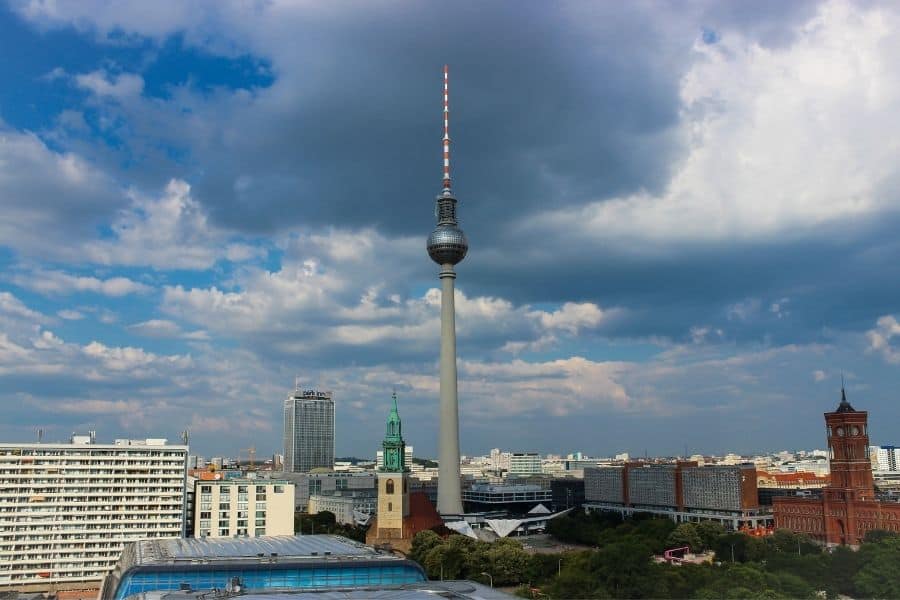
16. Mauerpark
My, how times change! This area is located along a former part of the Berlin Wall in a militarized zone called the “Death Strip.” Guards were stationed atop towers with orders to shoot any people trying to flee from East Berlin to West Berlin.
Now located at “Wall Park,” one of Berlin’s biggest and busiest flea markets, found every Sunday. Find vintage clothes, rare CDs, and other exciting and unique finds. Or, enjoy the entertainment with an outdoor singing session, Bearpit Karaoke, jugglers, and more.
It’s another fun and quirky slice of Berlin life worth seeing if you’re in town on a Sunday.
Mauerpark is located at Gleimstraße 55, 10437 Berlin, Germany.
17. Berlin River Cruise
Another popular thing to do is a Berlin river cruise on the Spree River. There’s something so magical about seeing a city from the water, and Berlin is no different. You’ll pass through Museum Island and the cathedral and see many other iconic Berlin buildings along the way.
Depending on the time of year you go, it’s another great way to see the city and avoid some crowds for a bit.
18. Schaubühne
For something a little different, check out Schaübuhne am Lehniner Platz. It’s the most renowned of the lavish state-funded theaters built in 1928. Germany is known as the capital of avant-garde theater, and this is the one to visit.
There is a sprinkling of modern and new, along with old classic productions. Most of the performances are in German, which is great if you want to practice your hand at the language. However, you will find some with subtitles in English and French.
Schaübuhne is located at Kurfürstendamm 153, 10709 Berlin, Germany.
19. Hackesche Hofe
Much of Berlin was rebuilt after World War II, so you’ll see a lot of “modern” architecture from the 1960s and 1970s. What’s entirely unexpected is an Art Nouveau complex, which is what you see with Hackesche Höfe.
It’s located in the Mitte district in the center of Berlin next to the Hackesher Markt. This courtyard complex has eight central interconnected courtyards. This style of architecture dates back to the 18th century and marked a significant expansion in Berlin. It was built to be a throwback to a prior time with a nod to the area’s history.
For an interesting twist, this historic courtyard complex was designed with a modern art deco facade, which is very rare in Berlin. The damage from WWII was minimal in this area, and it was restored in the late 1990s after it fell into disrepair.
Hackeshe Höfe is now a vibrant community home to an eclectic mix of cafes, apartments, cultural institutions, shops, a cinema, and businesses. It’s quintessential quirky Berlin—a bit off the tourist path with a touch of whimsy and a great place to go, along with the nearby market.
Hackeshe Höfe is located here. Hackesher Markt is located here.
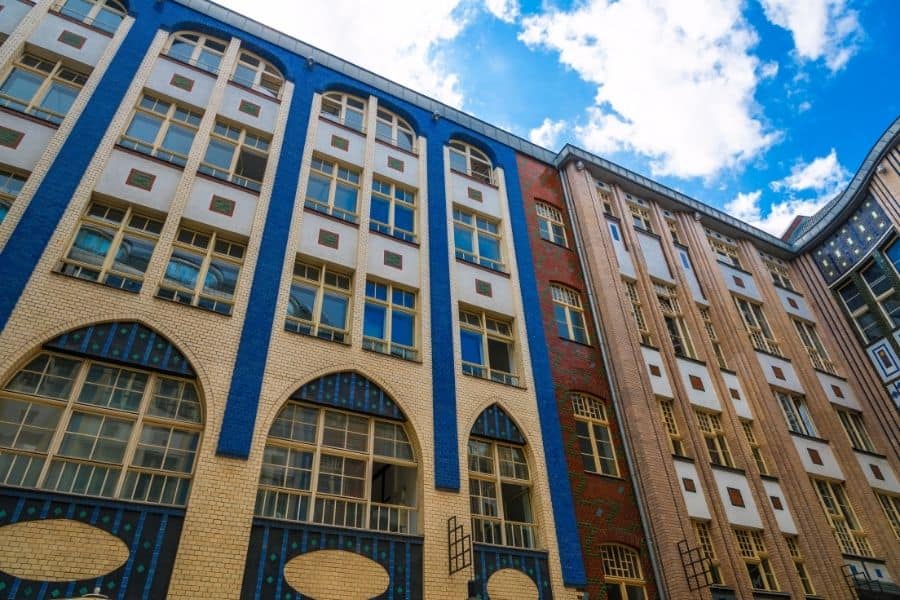

Where to Stay in Berlin
A large city like Berlin has a lot of options for hotels. Though the city is fairly expensive to visit, you can find budget deals with some great amenities and a range of offerings. Here are some great options to consider for your trip.
Budget: a&o Berlin Hauptbahnhof—You can get shared or private rooms at this modern hostel located close to the train station. The location is great, offering easy access to the subway system, and you’re already in Mitte, central Berlin. There’s even a gaming room!
Mid-Range: Adina Apartment Hotel—I stayed in an apartment similar to this one. It was modern, had many comfortable amenities, and was close to almost everything. This one is a ten-minute walk to the train station, which is incredibly convenient. There is another location near Hackesche Markt and a third near Checkpoint Charlie. I love staying in apartments as I feel more like a local and can grab some groceries and eat out less.
Luxury: Hotel Adlon Kempinski Berlin—If you’re seeking the finest luxury in one of the best locations in the city, you have found it with this hotel. Steps from Brandenburg Gate, it doesn’t get better than this. And, with a spa and an indoor pool, well, that just set it over the top!
Berlin Restaurants
There are a lot of amazing restaurants in Berlin. Of course, one of my favorites will forever be Augustiner in Gendarmenmarkt. It was not only an amazing meal but where I came across that uber-fun bachelor party. Memories…
Here are some great restaurants to check out:
- Augustiner (of course!)
- Frau Rauscher (there are a TON of restaurants in this area, and you can’t go wrong).
- Grill Royal—This upscale eatery on the river is a place to see and be seen.
- Buschbeck’s Restaurant—This one’s a bit of a trek, but it’s one of the top German restaurants according to TripAdvisor reviews. It’s not far from Charlottenburg Palace.
- Restaurant Tim Raue—Near Checkpoint Charlie, the nondescript outside hides this dining gem.
- Horváth—An Austrian old-timer located in the Kreuzberg neighborhood (not far from the Eastside Gallery).
German food is often quite heavy and rich, featuring schnitzel (fried cuts of meat), sausages, and the like. Be sure to try käsespätzle (a type of egg noodle with cheese) and different local dishes to see what’s your favorite. And, of course, don’t miss apple strudel for dessert!

When to Visit Berlin
The tourist season in Berlin and much of Germany is from May to September. It offers the best weather and the perfect season to enjoy outdoor cafes and parks. However, it’s when it’s the busiest with tourists. Shoulder season (spring and fall) can be a bit less expensive and usually has fewer tourists.
Temperatures from May to September average around 66°F to 75°F (48 to 58°C), perfect for travel. October to December ranges on average from 40 to 56°F (31 to 44°C), making it a bit colder, and December, when the Christmas markets are, is at the low end of that range.
How to Get Around Berlin
Berlin is a very walkable city and has a fantastic public transportation system. There is a U-Bahn subway system and an S-Bahn regional system that takes you nearly everywhere you want to go around the city. There are also trams, buses, and, of course, taxis.
Most tourists take the U-Bahn to get around Berlin. There are ten colored routes and nearly 175 stops. Prices are based on a zone system, A, B, and C, with most of the top attractions in the A and B zones.
The Schönefeld Airport is in zone C. A day ticket for A and B will run 8.60 Euros ($10.25 USD), and a one-way ticket is 2.90 Euros ($3.50 USD). A 7-day ticket costs 43 Euros (around $51 USD).
Tickets are required on all public transportation, and they can be purchased at multilingual ticket machines on the platforms for the U-Bahn and S-Bahn stations. Bus fares are paid to drivers, and tram tickets can be purchased inside the trains.
All tickets on the S-Bahn and U-Bahn must be validated by stamping them at the red or yellow boxes on the subway platforms. If you’re caught riding public transportation without a validated ticket, you may be fined 60 Euros (over $72 USD).
The Fun (and Quirky) Side of Berlin
There is something about Berlin that just makes me smile. Which is funny as when I first arrived, I was sorely disappointed. I know it sounds crazy, but as an architecture addict lover, I was expecting to see grand Europe at its finest. When I saw what looked like I walked back into the 60s, I wasn’t really excited.
I was staying for a few days, so I decided to dig in to see what Berlin offers. I’m so glad I did as my initial impressions couldn’t have been more wrong! Berlin is a fun city with a quirky side that took a little while to see. You might think with the many Holocaust memorials and museums that, it may be a tad depressing to visit, and in truth, there is some of that.
But the feeling I got (and this is just my impression), is that the people of Berlin recognize their past and pay homage to it through the many memorials. However, they do not want to be defined by it. They have apologized, and they are moving on. So, what I felt was a city coming out from under this heavy weight with an air of fun.





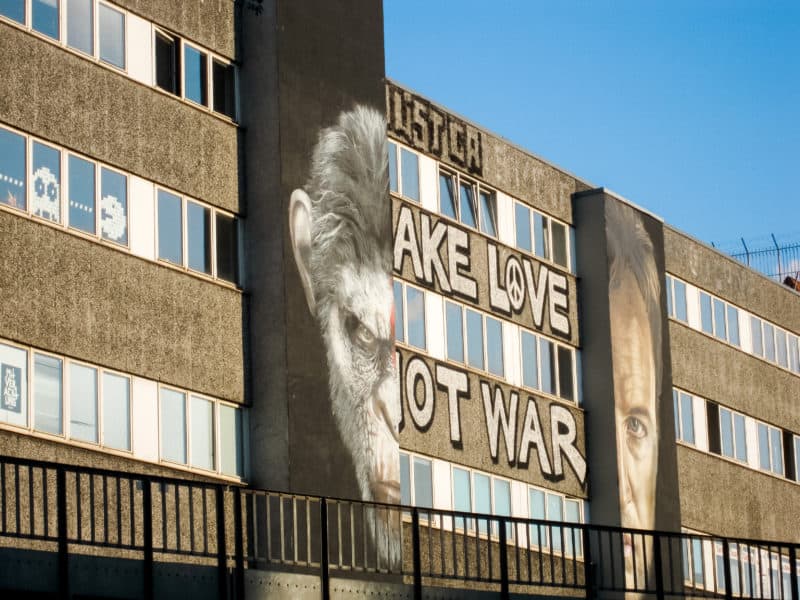

Quirky Berlin
Yes, there is a Duck Shop! And another funny thing was the Ampelmann. They brand and take joy in/poke fun at the two little men who are on the traffic signs. You get to know the green walking one very well wandering around the city!
A funny thing happened on my last night when I was eating at a restaurant. I was traveling solo, and a large group of guys (50+) showed up all rowdy and ready for fun. They were a group bachelor party from the U.K.
The man of honor was dressed in S&M attire: leather hot shorts, a leather vest, a face mask, a whip, a leash, and several other things. They were hilarious! And while they were not from Berlin, I had a feeling that Berlin was the perfect setting.
When I asked for a photo, I got this (note the waiter was a total sport getting in on the action). A second later, the waiter busted out laughing, and people were crossing the street to see what was happening.
In my book, this was the perfect end to my trip to quirky and fun Berlin.

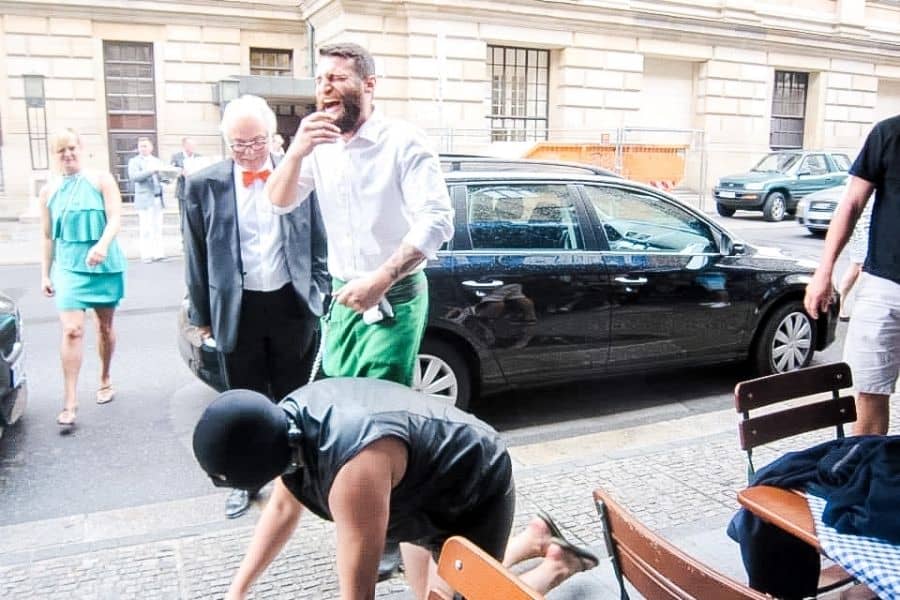
So, Is Berlin for You?
I found Berlin to be unlike any other city I have seen in Europe. It’s definitely a bit quirky, and it seems to enjoy being a tad different. Go with the right expectations, and peel back the layers to see the true Berlin heart of this interesting and unique city.
There’s a lot to see and do, and you may just love the quirky side!
You Might Also Like
- The Best Places to Visit in Germany
- Neuschwanstein—One of the Most Famous Castles in Germany
- Why You Should Visit Garmisch-Partenkirchen
- 16 Interesting and Unique Things to Do in Munich
- Visiting the Zugspitze: the Tallest Mountain in Germany
- How to Make the Most of One Day in Salzburg
- Top 10 Things to Do in Potsdam in One Day
Like it? Pin it!
